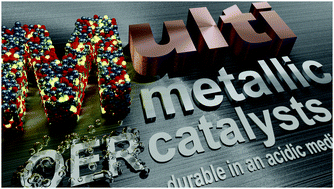Multimetallic nanostructures for electrocatalytic oxygen evolution reaction in acidic media
Abstract
The proton exchange membrane water electrolyzer (PEMWE), driven by electrocatalysts, is a promising green technology for producing hydrogen. It provides high current density (0.6–2.0 A cm−2 at 1.75–2.20 V per cell) and high energy conversion efficiency (80–90%). Ir-Based catalysts are the current state-of-the-art electrocatalyst materials, and have been widely utilized because they offer high oxygen evolution reaction (OER) activity and moderate resistance to acidic corrosion. However, the OER durability of Ir-based catalysts does not meet the practical demands. At low pH values the anodic potential (1.8–2.2 V) driving the OER usually oxidizes Ir-based catalysts and makes them vulnerable to dissolution, which in turn degrades the electrocatalytic activity and long-term stability. In order to address the problems associated with these Ir-based catalysts, a number of multimetallic compositions have been investigated, and, notably, increases in mass activity and durability compared with Ir-based catalysts have been accomplished. Here, notable recent advances in the development and understanding of multimetallic electrocatalysts toward the OER in acidic media are presented. Synthetic strategies, synergies in multimetallic systems, and their catalytic performances are systematically discussed in an attempt to advance the development of economical and eco-friendly hydrogen production. Lastly, the challenges and the outlook for further development are discussed.

- This article is part of the themed collections: Functional materials for sustainable future - Vision from Korean scientists and 2021 Materials Chemistry Frontiers Review-type Articles


 Please wait while we load your content...
Please wait while we load your content...